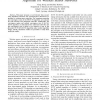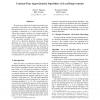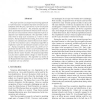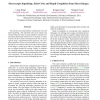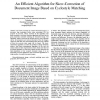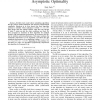GLOBECOM
2008
IEEE
15 years 1 months ago
2008
IEEE
Abstract—This paper proposes a novel discrete time secondorder distributed consensus time synchronization (SO-DCTS) algorithm for wireless sensor networks. The consensus properti...
FOCS
2008
IEEE
15 years 1 months ago
2008
IEEE
We present a technique for transforming classical approximation algorithms into constant-time algorithms that approximate the size of the optimal solution. Our technique is applic...
FOCS
2008
IEEE
15 years 1 months ago
2008
IEEE
The deletion–contraction algorithm is perhaps the most popular method for computing a host of fundamental graph invariants such as the chromatic, flow, and reliability polynomi...
FOCS
2008
IEEE
15 years 1 months ago
2008
IEEE
We use a Bayesian approach to optimally solve problems in noisy binary search. We deal with two variants: • Each comparison is erroneous with independent probability 1 − p. �...
FGR
2008
IEEE
15 years 1 months ago
2008
IEEE
This paper presents an unsupervised learning approach to video-based face recognition that does not make any assumptions about the pose, expressions or prior localization of landm...
FGR
2008
IEEE
15 years 1 months ago
2008
IEEE
This paper presents a novel algorithm for estimating complex human motion from 3D video. We base our algorithm on a model-based approach which uses a complete surface mesh of a 3D...
FGR
2008
IEEE
15 years 1 months ago
2008
IEEE
In this paper, we propose an algorithm for sustained tracking of humans, where we combine frame-to-frame articulated motion estimation with a per-frame body detection algorithm. T...
CVPR
2008
IEEE
15 years 1 months ago
2008
IEEE
We present a novel algorithm for simultaneous color and depth inpainting. The algorithm takes stereo images and estimated disparity maps as input and fills in missing color and d...
CSSE
2008
IEEE
15 years 1 months ago
2008
IEEE
—The skew-correction of scanned document image is a necessary step undergone before some processing. For the purpose of practical, robust, real-time of the algorithm, this paper ...
CLUSTER
2008
IEEE
15 years 1 months ago
2008
IEEE
—Divisible load model allows scheduling algorithms that give nearly optimal makespan with practical computational complexity. Beaumont et al. have shown that their algorithm prod...
